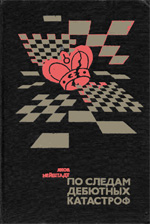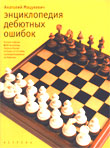
Monthly Special $$ offers - FREE books and Savings
A Fun and Productive Way to Prepare for a Game (especially for casual players)
Level - beginner through advanced.
| Many years ago I recall myself traveling across the country to junior chess tournaments. I had category 2 (approx. Class A, using the USCF rating scale) and improving. Tournaments lasted 10 days, and no computers were available to get the info, store games and analyze. The bi-annual issues of Chess Informant were the only source for opening preparation, and we only had 1 copy in our club's library. Everyone had to share. Moreover, with no copy-machines available, if you found a relevant game, you had to record it in your notebook or on index cards... |
 |
 |
As a kid you had to travel light, as no one was there to carry your bags. Hence, you had to plan carefully what chess books to take with you. My favorite book was Neishtadt's "Po Sledam Debutnih Katastrof" ("Following Opening Accidents.") This was an opening reference book with collections of fairly common openings and examples of typical tricks in these openings. I used it both to prepare for my games (to learn specific lines and to get a general feel for the opening) as well as to sharpen my tactics. I had a great experience with that book! |
| Fast forward to present time - many train with computers, even carry them to the tournaments. Hence, it seem like a completely different environment and methods should apply. You can easily buy 100 different opening books before you feel completely secure in every opening. Or You can buy a repertoire book (like Alburt's "Chess Openings for White & Black, Explained (A Complete Repertoire)) to get a comfortable in various openings, although not all lines picked by authors would suit you. I certainly would vouch for the latter, but ... I prefer to mix old proven methods with the newer tools. Here is a 'little' book (it weighs 4 pounds) that I find both enjoyable and indispensable - basically 800 pages, 4000 games from all openings played by masters all the way through world champions, that ended in 13 moves or less. You can read my review here. The book is in English / Russian. All openings are classified. |
 |
| About 3 weeks ago my 1100-rated student B. (a happily retired gentleman) came for a
lesson in the afternoon and told me that in about 6 hours he has a rated game to
play. So, I pulled the above mentioned book
and we started going over games from some openings that he was likely to see that night. We
spend the entire 2 hours reviewing 10-15 games, trying to replay them from
memory, and considering possible variations that didn't happen in the games. He
enjoyed the lesson and told me that he learned a lot as well felt shaper
tactically. I was glad to hear that. I felt even better when the next day I got this e-mail. Igor, Thank you. Played best ever and beat J. K., 1646. It was cool and now in the running for the upset prize of 50 dollars. B. When I am working with aspiring junior rated 2000+, our goal is to win tournaments and earn titles. And based on that, we determine how successful is our work together. When I am working with causal players, e-mails like this is the best indicator of our success. |
==============================================================================================
I have a couple of copies of this book, in
case you'd like to order it. Once I run out of stuck it would take at least 2 months to
get more, if there are any available. Check it
here!
==============================================================================================
What do you think about this article? How did you do? For comments,
corrections send email or use
this
form
More on chess training (serious and enlightening) in my books:
|
|
Chess Exam and Training Guide (2004) $24.95 + shipping Chess Exam and Training Guide: Tactics (2007) $19.95 + shipping CE + CE Tactics (Holiday Special! Free chess cartoon calendar $8, while supplies last) - $39.95 - insured shipping in US is included |
Copyrighted @ 2009 Igor Khmelnitsky
For comments or permission to reprint please send inquires via email or this form
(*Bonwell, C., & Eison, J. (1991). Active learning: Creating excitement in the classroom (ASHE-ERIC Higher Education Report No. 1). Washington, DC: George Washington University, p. 2)